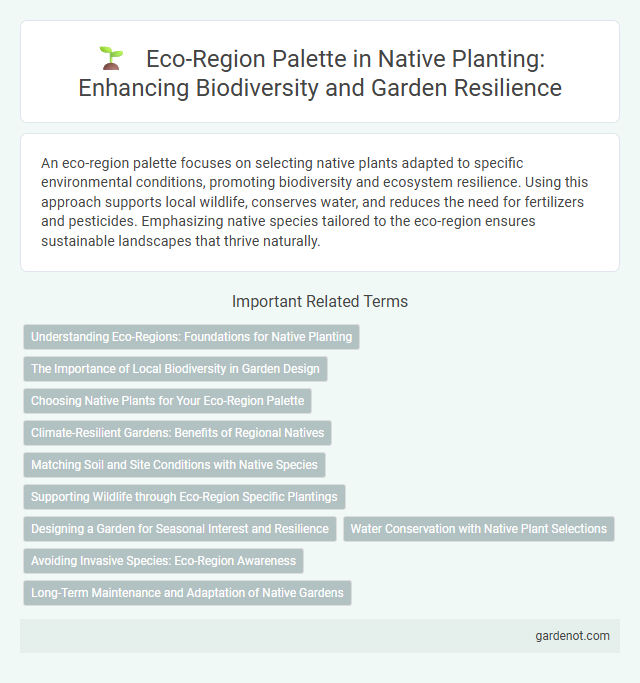An eco-region palette focuses on selecting native plants adapted to specific environmental conditions, promoting biodiversity and ecosystem resilience. Using this approach supports local wildlife, conserves water, and reduces the need for fertilizers and pesticides. Emphasizing native species tailored to the eco-region ensures sustainable landscapes that thrive naturally.
Understanding Eco-Regions: Foundations for Native Planting
Eco-regions define distinct geographic areas with specific climate, soil, and ecological characteristics that shape native plant communities. Using an eco-region palette ensures selection of native species adapted to local environmental conditions, promoting biodiversity and ecosystem resilience. Understanding these regional boundaries and their unique habitats guides sustainable planting decisions and supports habitat restoration efforts.
The Importance of Local Biodiversity in Garden Design
Incorporating an eco-region palette in garden design enhances local biodiversity by selecting native plants adapted to the specific climate, soil, and ecological conditions of the area. Native species support indigenous wildlife, including pollinators and birds, fostering a balanced ecosystem and promoting natural pest control. Emphasizing local biodiversity through native planting ensures sustainable landscapes that contribute to regional ecological resilience and conservation efforts.
Choosing Native Plants for Your Eco-Region Palette
Selecting native plants tailored to your eco-region palette enhances local biodiversity and ecosystem health by supporting native pollinators and wildlife. Understanding the specific climate, soil type, and moisture levels of your eco-region ensures optimal growth and sustainability for native species. Incorporating plants such as prairie grasses in grassland regions or drought-tolerant succulents in arid zones creates resilient, low-maintenance landscapes that conserve water and reduce the need for fertilizers.
Climate-Resilient Gardens: Benefits of Regional Natives
Climate-resilient gardens thrive by incorporating native plants adapted to local eco-region palettes, ensuring enhanced survival rates and reduced water usage. Regional natives support biodiversity, providing habitat and food sources for native pollinators and wildlife while maintaining ecosystem balance. Utilizing these plants fosters soil health and resilience against extreme weather, promoting sustainable gardening practices tailored to specific climatic conditions.
Matching Soil and Site Conditions with Native Species
Selecting native plants that thrive in specific eco-regions requires matching soil types, moisture levels, and sunlight exposure to the species' natural habitat preferences. Soils with proper pH, texture, and drainage support root health and long-term plant vigor, ensuring successful ecosystem restoration and biodiversity enhancement. Incorporating native species suited to local site conditions reduces maintenance needs and promotes resilient, self-sustaining landscapes.
Supporting Wildlife through Eco-Region Specific Plantings
Eco-region specific planting palettes enhance biodiversity by using native species adapted to local climates and soils, providing optimal habitats for indigenous wildlife. These plantings support pollinators, birds, and mammals by offering food, shelter, and breeding grounds essential for their survival. Implementing eco-region tailored landscapes promotes ecosystem resilience and helps maintain natural ecological balance.
Designing a Garden for Seasonal Interest and Resilience
An eco-region palette leverages native plant species adapted to local climate and soil conditions, ensuring garden resilience and minimizing maintenance. Incorporating a diverse range of perennials, shrubs, and grasses provides year-round visual interest through varied textures, colors, and flowering times. Strategic planting enhances ecosystem support by attracting pollinators and improving soil health, fostering a sustainable and dynamic garden environment.
Water Conservation with Native Plant Selections
Native plant selections within an eco-region palette significantly enhance water conservation by thriving in local climate conditions and requiring minimal irrigation. Deep-rooted native species improve soil structure and water infiltration, reducing runoff and promoting moisture retention. Incorporating drought-tolerant plants such as California lilac, purple coneflower, and switchgrass optimizes sustainable landscaping with efficient water usage.
Avoiding Invasive Species: Eco-Region Awareness
Selecting plants native to a specific eco-region ensures ecological harmony and supports local wildlife by maintaining natural biodiversity. Avoiding invasive species prevents disruption to native habitats and reduces competition for resources among indigenous flora. Utilizing an eco-region palette fosters sustainable planting practices tailored to climate, soil, and ecosystem characteristics unique to the area.
Long-Term Maintenance and Adaptation of Native Gardens
Long-term maintenance of native gardens in an eco-region palette requires selecting plant species that are resilient to local climate variations and soil conditions, ensuring sustainable growth and reduced resource input. Adaptive management practices, such as seasonal pruning and monitoring for invasive species, support ecosystem balance and biodiversity over time. Integrating native plants with varying drought tolerance and phenology enhances garden stability and resilience to environmental changes.
Eco-region palette Infographic

 gardenot.com
gardenot.com